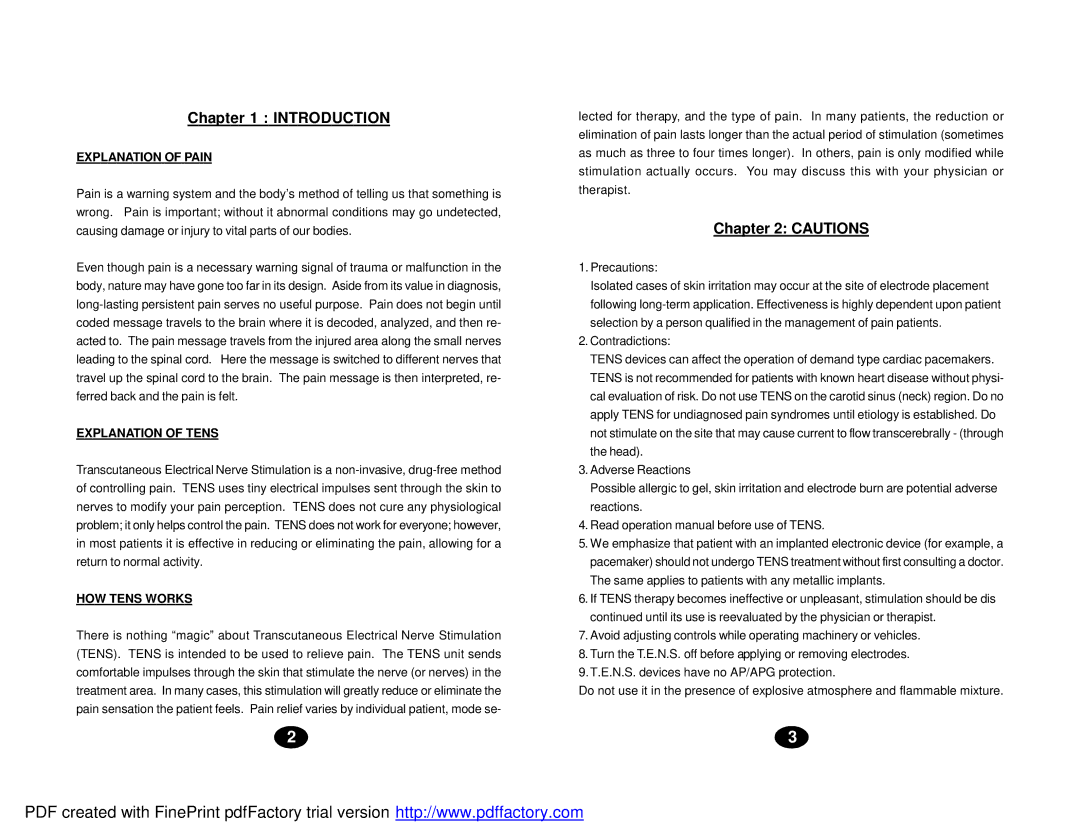Chapter 1 : INTRODUCTION
EXPLANATION OF PAIN
Pain is a warning system and the body’s method of telling us that something is wrong. Pain is important; without it abnormal conditions may go undetected, causing damage or injury to vital parts of our bodies.
Even though pain is a necessary warning signal of trauma or malfunction in the body, nature may have gone too far in its design. Aside from its value in diagnosis,
EXPLANATION OF TENS
Transcutaneous Electrical Nerve Stimulation is a
HOW TENS WORKS
There is nothing “magic” about Transcutaneous Electrical Nerve Stimulation (TENS). TENS is intended to be used to relieve pain. The TENS unit sends comfortable impulses through the skin that stimulate the nerve (or nerves) in the treatment area. In many cases, this stimulation will greatly reduce or eliminate the pain sensation the patient feels. Pain relief varies by individual patient, mode se-
2
lected for therapy, and the type of pain. In many patients, the reduction or elimination of pain lasts longer than the actual period of stimulation (sometimes as much as three to four times longer). In others, pain is only modified while stimulation actually occurs. You may discuss this with your physician or therapist.
Chapter 2: CAUTIONS
1.Precautions:
Isolated cases of skin irritation may occur at the site of electrode placement following
2.Contradictions:
TENS devices can affect the operation of demand type cardiac pacemakers. TENS is not recommended for patients with known heart disease without physi- cal evaluation of risk. Do not use TENS on the carotid sinus (neck) region. Do no apply TENS for undiagnosed pain syndromes until etiology is established. Do not stimulate on the site that may cause current to flow transcerebrally - (through the head).
3.Adverse Reactions
Possible allergic to gel, skin irritation and electrode burn are potential adverse reactions.
4.Read operation manual before use of TENS.
5.We emphasize that patient with an implanted electronic device (for example, a pacemaker) should not undergo TENS treatment without first consulting a doctor. The same applies to patients with any metallic implants.
6.If TENS therapy becomes ineffective or unpleasant, stimulation should be dis continued until its use is reevaluated by the physician or therapist.
7.Avoid adjusting controls while operating machinery or vehicles.
8.Turn the T.E.N.S. off before applying or removing electrodes.
9.T.E.N.S. devices have no AP/APG protection.
Do not use it in the presence of explosive atmosphere and flammable mixture.
3
PDF created with FinePrint pdfFactory trial version http://www.pdffactory.com
